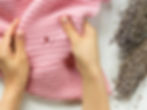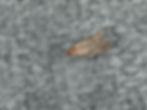How to Get Rid of Clothes Moths and Protect Your Favourite Clothes
- Sue Spencer
- Jul 22
- 8 min read
Updated: Sep 9
It usually starts with a tiny hole, then another and another.. that's when it hits you: your favourite jumper has become an all-you-can-eat buffet for clothes moths.

I've seen it in my clients' homes time and time again - nothing makes your heart sink faster than realising your favourite knit has become a moth's lunch - they always seem to go for the sentimental pieces, don't they? It's frustrating, disheartening and can be surprisingly costly.
But don't worry. This guide that I share with my clients will walk you through exactly how to get rid of clothes moths, how to treat your clothes, and how to prevent them from coming back. Whether you're dealing with a minor clothes moth infestation or a full-blown problem, this step-by-step plan will help you reclaim your wardrobe, and keep it protected for good.
In this blog:
This blog includes links to clothes moth treatment and prevention products on Amazon - I receive a small commission on sales at no extra cost to you.
Clothes Moth Myth-Busting
You may be surprised to hear that it's not actually the moths that are eating your clothes and carpets – it's their larvae. These tiny, almost invisible hatchlings love nothing more than a dark, undisturbed corner and natural fibres like wool, cashmere and silk – especially if clothes have been put away unwashed with traces of food or sweat on them.

What do clothes moths love?:
Packed wardrobes with poor air circulation - this is why breathable clothing storage is so important.
Clothes that weren't cleaned before storage
Quiet corners we don't often check (think the bottom of wardrobes, between skirting boards and furniture)
Humid environments -
The best way to get rid of moths once and for all is to break the lifecycle by making sure you get rid of both the moths and their larvae.
Signs That You Have Clothes Moths - What to Look Out For
Now that you know what's causing the damage, here's how to identify if you have a problem. There are a few telltale signs to look out for...
Tiny holes in clothes or thin tracklines in clothes
Small cocoons or tube-like cases stuck to clothes or in drawers
Powdery debris seen under clothes in the wardrobe or in drawers – this could be larvae droppings or the remains of fabric
Tiny beige golden moths that flutter in darker areas or around the floors
Small, cream-coloured larvae (about 1cm long) that look like tiny caterpillars
Know your enemy - the clothes moth..
Clothes moths are different from other house (pantry) moths. They're smaller, golden-beige in colour, and avoid light. Unlike other moths that fly around lights, clothes moths scurry away when disturbed.

When are clothes moths most active?
Clothes moths are most active from late spring (May) through October, and you'll typically see them in the evening or early morning.
If you've spotted holes or a flying moth, it's time to take action immediately.
Seen a clothes moth - when to take action
If you spot a single moth or small hole, isolate the affected area straight away. Remove any damaged items and seal them in bags. Then inspect the surrounding items. Don't wait to do this - one female moth can lay up to 100 eggs, so the sooner you deal with it, the better.
How to Get Rid of Clothes Moths - Your Step by Step Guide
Getting rid of clothes moths isn't a quick fix - expect the full process to take 2-3 weeks to complete thoroughly. However, once it's done, it's easy to maintain and keep the space clean and moth-free. It's also a great opportunity to edit your wardrobe, combine it with a seasonal switch, and make sure to check that everything still sparks joy.
1: Empty Out and Declutter Wardrobes and Drawers
Deep clean all of your clothes storage spaces:
Remove everything from the affected cupboards or drawers, including lining paper. I always bin and refresh this with new paper. You can use a scented liner to repel moths (link to further down the article).
Vacuum thoroughly using a crevice tool, get into all the corners, floorboards and drawer runners
Make sure you move any furniture and vacuum behind and underneath it. You should also vacuum any upholstered furniture (chairs, sofas etc), especially along seams
Clean and disinfect any storage boxes or containers
Important: Once you've done this, empty your vacuum cleaner outside your home straight away to ensure you don't risk introducing the larvae to other areas of your home.
Give your wardrobes a wipe down with soap and water to freshen them up and leave them open to air whilst you move on to the next step: tackling the clothes themselves.
2: Clean All Your Clothes - Yes, Every Single Item
To ensure that you break the moth lifecycle, you need to wash or dry-clean absolutely everything - even items that look untouched, as they could be hiding eggs or larvae.
Machine-washable clothes:
Use the highest temperature that's safe for the fabric as heat is key to killing the larvae
Use a steamer or iron your clothes (especially around cuffs and collars) to ensure you have killed off any remaining larvae or eggs
Dry clean only or delicate items:
If you have items that you can't wash, freezing them is another way to deal with moth eggs
Seal the clothes in a bag
Freeze them for at least 3 days – thicker items will need to be frozen for longer (up to 2 weeks) – it's worth it to protect your favourite coats and jumpers

What to do with severely moth-damaged items:
If you've discovered damage on something valuable or sentimental, don't rush to throw it out. Look into professional invisible mending or reweaving services - it's not a budget option, but if it means saving a beloved item, it can be well worth the investment
How To Protect Your Wardrobe From Clothes Moths
Once you've cleaned everything, put your edited wardrobe back in a way that keeps it moth-free using proper storage techniques:
Tightly packed wardrobes are a moth's dream. When clothes are crammed together moths and their larvae can hide easily and nibble their way through garments undisturbed.

Give your clothes room to breathe - a little space between hangers can make a big difference. Rotate seasonal clothing regularly to keep things moving and deter moths from settling in.
Only store clean clothes - moths are attracted to skin oils, sweat and food particles.
Wash before storing - always wash or dry clean your wool and cashmere jumpers before packing them away for the season. Moth dammage often isn't visible until months later.
Use breathable, moth-proof storage bags - I personally use these for my delicate or cashmere knits. They keep moths out while allowing air to circulate, preventing musty smells and fabric damage.
How to Store Wool and Cashmere Jumpers Safely
Storing wool or cashmere jumpers and silk properly is key to preventing moth damage. Always wash or dry clean garments before putting them away and make sure they are completely dry. Use breathable protective storage bags or fabric garment covers to keep items safe while still allowing air to circulate. This prevents both moth damage and that musty smell that can develop in sealed storage containers.
Natural moth repellent for clothes that actually work:
Cedarwood, lavender, rosemary, and mint are all traditional natural deterrents as they are scents that clothes moths dislike. They won’t kill existing larvae (you’ll need to follow the cleaning steps above for that), but they discourage adult moths from laying eggs in your drawers and wardrobes.
Here are some tried-and-tested options:
Cedarwood blocks or balls are naturally effective and long-lasting. Refresh with a few drops of cedar oil every 6–12 months to keep the scent strong.
Herbal sachets – dried lavender, rosemary, or mint in breathable cotton or muslin bags work beautifully. Replace or refresh every couple of months.
Natural oils – A few drops of essential oil (lavender, rosemary, peppermint or cedarwood) on a cotton pad, tissue, or diffuser stone can help keep moths away. Just be careful not to place them directly on or too close to your clothes, as the oils can stain fabrics. Stick to pure, natural oils rather than synthetic or heavily perfumed versions—they may smell nice, but they’re not as effective against moths.
Use one of these options once you’ve completed your moth clean-up and keep it topped up as part of your regular wardrobe care routine.
Pheromone Traps for Monitoring Moths
Pheromone sticky moth traps are a simple but effective way to monitor for clothes moths. They attract and catch male moths, helping you keep track of activity levels and interrupt the breeding cycle.
Place them low down in wardrobes, drawers, and storage areas, they’re non-toxic and safe to use around clothes.
Replace every 12 weeks (or as directed) to keep them effective.
These aren’t enough to treat an existing infestation as they don’t catch females or larvae, but they’re excellent for early detection and reducing the chance of reinfestation.
Use them as part of your long-term prevention strategy, especially during peak moth season from May to October.
Amazon Clothes Moth Products:
You can buy my favourite natural deterrent sachets, sprays, drawer liners and essential oils that I use with clients here on my Amazon store.
Create a Maintenance Routine
Check important items each month and look out for the early warning signs (holes and larvae).
I recommend rotating seasonal items and removing everything from your wardrobe every six months - this give you an opportunity to check all your clothes and vacuum thoroughly. Take a look at How to do a seasonal wardrobe switch the KonMari way for a step-by-step maintenance guide.

When to Call in Professional Help
Sometimes the problem is beyond DIY solutions. Consider calling in a professional pest control solution if:
· You've tried the above steps but moths keep returning after 2-3 treatment cycles
· You have a large collection of valuable vintage or designer items
· The clothes moth infestation has spread to carpets or upholstery
· You're dealing with multiple rooms
The professional treatment may involve chemical, pesticide or heat treatment to deal with the moth infestation. Companies will usually offer ongoing monitoring and prevention plans to ensure they have dealt with the clothes moth issues.
The final say…
Prevention is always easier than treatment. Regular wardrobe maintenance, proper cleaning before storage and creating an environment that moths hate will save you both heartache and money. Remember, moths are persistent, but with the right approach, you can protect your favourite pieces for years to come.
The key is consistency - make wardrobe checks part of your seasonal routine, and you'll catch any problems before they become expensive disasters. Your future self (and your favourite jumpers) will thank you.
Are you ready to start living A Life More Organised?

Hi, I’m Sue, founder of A Life More Organised, professional home organiser and certified KonMari Consultant based in Hampshire, UK.
I had the privilege of training with Marie Kondo and I now use her method to help growing families and empty nesters rightsize their homes.
Together we Declutter and Organise to clear space, time, and the overwhelm that builds up when life gets busy, so you can focus on what matters most - enjoying life.
Get in touch for a no-obligation chat about how I can help.
m: 07740 782575 www.alifemoreorganised.co.uk
I'd love to keep in touch - why not follow me on Instagram or join in the conversation in my Facebook group

















